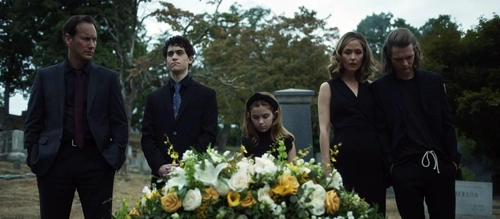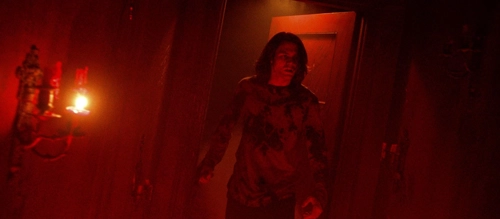Insidious: The Red Door (2023) Review

Insidious: The Red Door (2023)
Director: Patrick Wilson
Screenwriter: Scott Teems
Starring: Ty Simpkins, Patrick Wilson, Rose Byrne, Sinclair Daniel, Peter Dager, Joseph Bishara, Andrew Astor
The first film in the Insidious film franchise is a touchstone of 2010s paranormal horror with its dissonant spooky strings and striking imagery. It twisted the “haunted house” story into the story of a haunted family, and explored astral projection in a horror context. Everything that came after couldn’t manage anything that didn’t involve sudden loud noises that startled us more than they horrified us. But Patrick Wilson and the team behind The Red Door have managed to successfully correct the franchise’s course, and in doing so have provided a satisfying ending to the family at the core of the first two movies.
Insidious: The Red Door follows the Lambert clan around a decade after the events of Insidious and Insidious: Chapter 2. Josh (Wilson) and Renai (Rose Byrne) have divorced, Josh’s mom has recently died, and their son Dalton (Ty Simpkins) is off to art school. There’s tension between father and son, and the events of the first two films come back to haunt them both literally and metaphorically. The most important scene from Chapter 2, where Josh and Dalton are hypnotized to forget what happened, is shown at the beginning to give full context for what comes next.
It’s an impressive directorial debut from Patrick Wilson. He was given the task of essentially reverting and redirecting a major horror franchise, and managed to make a film that feels singular and unique within those limitations. This isn’t simply another tale of someone being haunted and having to exorcise them, it presents a real struggle between entities in The Further (the astral projection realm) and humans on Earth, and establishes that fight and the powers well without the need to see the other films.
The first key to Insidious: The Red Door is the foundation of its story. While the third and fourth films involve Elise, the medium from the first film, they tell stories that have no impact on the rest of the franchise. You can’t go back and watch the third film and see how that encounter with a demon really impacted her character and affected her actions in the “future” (other than the recruitment of her ghost-hunting assistants). There’s no root other than her character being in other movies. But The Red Door uses the consequences of the first two films to impact its characters and create meaningful, interesting family drama – specifically the father-son story. The disconnection from each other and their history change the relationship between Dalton and Josh, and Josh fights his own demons involving his father’s abandonment of him at a young age. This foundation of story and character turns the demons from cheap thrills into symbols for generational trauma and familial strife – while this is often the case with horror, it’s scantly executed beyond the surface level.
The performances of Patrick Wilson and Ty Simpkins also help emphasize these themes, showing that the impact an experienced performer like Wilson can have as a director is invaluable. Being a post-pandemic, relatively low-budget film, there’s rarely a moment where there are more than a couple of characters on screen (which drives home the emotional isolation that both Josh and Dalton are feeling), and each actor makes the most of it.

Sinclair Daniel brings a lot of quirkiness and fun as Chris, Dalton’s roommate who is happy to listen to and help the troubled teen. Patrick Wilson embodies a weariness that really drives home the image of the depressed divorcee haunted by physical and emotional demons. But Ty Simpkins, reprising his role from the first two films, steals the show as the brooding artist. A scene in which Josh and Dalton briefly fight about their interpersonal issues shows there’s so much simmering under the surface for both characters, and their actors are able to portray those untapped emotions well, even if it’s unclear exactly what those feelings and thoughts are.
While story and character are important for the scares, the horror moments are the primary mode of channelling horror for the audience, and this may be where Wilson really hits the mark. Gone are the spooky strings and sudden sounds accompanied by a figure jumping in from outside the frame. Instead, there’s a lot of silent, visual horror taking place in negative space. Lighting and incomplete imagery distort shots and objects in ways that are unsettling. There are surreal uses of space and edits that can frighten more than any jump scare from the last film, The Last Key (2018). The Further has also been modified into more of a strange, extant realm that audiences don’t get a good view of. One great horror scene involves Josh playing a memory game during broad daylight as a figure slowly approaches. It’s full of anxiety and apprehension on top of the fear that comes along with aging and losing memory, and it manages all that without the lesser jump scare tricks.
Could the Insidious franchise continue? Sure. Studios are always looking for large profit margins on cheap horror films, and established names typically carry the most weight. But this film is surely the end of the Lambert family saga, giving them a definitive conclusion that the IP owners shouldn’t go back on.
The most important question from this film is, “What will director Patrick Wilson do next?” Might he tackle a Conjuring film? An original film? Will he stay in horror? This was a huge step in his career, and it will certainly be interesting to see if this directorial debut leads to greater heights for one of the 21st century’s most iconic horror film faces.
Score: 15/24

